The week at a glance
- Snowy Owls in Londonderry and Mayo
- White-tailed Eagle in Hertfordshire, Bedfordshire and Kent
- Parrot Crossbill and Paddyfield Warbler still in West Sussex
- Spanish Sparrow and Dark-eyed Junco still in Hampshire
- Northern Waterthrush still on Scilly
A week of contrasting weather conditions (ranging from –16°C recorded in Lincolnshire on Friday night to +12°C in Newcastle-upon-Tyne by Wednesday) witnessed another solid showing of rare and scarce birds across Britain and Ireland. This included a couple of quality new surprises and, despite the chronic lack of Waxwings to report this winter, Bird News Extra remains surprisingly busy for mid-February.
In Northern Ireland, last week's Snowy Owl was relocated at Altikeeragh Nature Reserve (L'derry), being seen to 13th. Another, a female, was found on a peat bog near Ballycastle (Mayo) on 13th. With such a heavy southward influx occurring across much of North America, it seems logical to assume that these birds are Nearctic in origin.

Snowy Owl, Altikeeragh, Londonderry (Photo: Ronald Surgenor)
The Paddyfield Warbler was still at Pagham Harbour (W Sussex) throughout, although views were always distant and often brief, and it was not seen at all on Saturday. Also in the county, a lack of interest was presumably to blame for reduced reports of the female Parrot Crossbill at Black Down. However, it was noted by its favoured drinking pool on 11th and 14th.
Just across in Hampshire, the Spanish Sparrow was still around Calshot all week and the Dark-eyed Junco was still at Hawkhill Inclosure to 14th, although the latter appears to have become more elusive and was not seen at all on 15th. Down in the southwest, the Northern Waterthrush appears to have survived the harshest spell of the winter: it was seen again at Lower Moors, St. Mary's (Scilly) on 14th.

Spanish Sparrow, Calshot, Hampshire (Photo: Dave Hutton)
The adult Lesser White-fronted Goose was still commuting between Cantley and Buckenham Marshes (Norfolk) with the Taiga Bean Goose flock throughout the week. With temperatures now rising more, the departure of these birds must be imminent. The Ross's Goose was again at Newton Marsh (Cumbria) on 12th before relocating across the Solway to Caerlaverock (Dumf & Gall) on 15th; up to two were still roaming northwest Norfolk throughout the week. The white-morph Snow Goose was again at Big Isle (Donegal) on 10th, and the blue morph was again at Lower Lough MacNean (Fermanagh) on 15th. Three were still at Aldcliffe Marsh (Lancs) on 11th.
A Red-breasted Goose with Dark-bellied Brents at Felixstowe Ferry (Suffolk) from 10th may or may not be one of the county's 'ferals', although its choice of carrier species is promising and thus it is likely to be given the benefit of the doubt. Just along the coast, the Essex bird was relocated at Bradwell-on-Sea from 12th, while the Devon bird was still at Topsham throughout the week. Finally, one was again with the Solway Barnacles at Carsethorn then Loaningfoot (Dumf & Gall) from 12th.

Red-breasted Goose, Loaningfoot, Dumfries & Galloway (Photo: Darren Robson)
Three Richardson's Canada Geese were still at Ballygilgan Nature Reserve (Sligo) on 11th–12th; sightings on Islay (Argyll) came from Loch Gruinart on 12th, and Mulindry and Bridgend on 13th. One was with Canada Geese at Blair Drummond (Forth) on 13th, and a possible was reported with Barnacles at Budle Bay (Northumberland) the same day. The dark-breasted Todd's Canada Goose was again near Termoncarragh Lough (Mayo) on 10th and 13th, with another at Carsethorn (Dumf & Gall) on 13th, relocating to nearby Loaningfoot on 15th. A Taverner's Canada Goose was reported at Bridgend, Islay on 13th.

Todd's Canada Goose, Loaningfoot, Dumfries & Galloway (Photo: Darren Robson)
A better showing of ten Black Brants included two Irish records from Killala Bay (Mayo) on 12th and Fethard-on-Sea (Wexford) on 14th. British records included two at Wells-next-the-Sea (Norfolk) on 11th–12th, and a new bird at Penhill Marsh (Devon) from 11th. Others were reported in Hampshire, West Sussex, Suffolk and Essex (2).
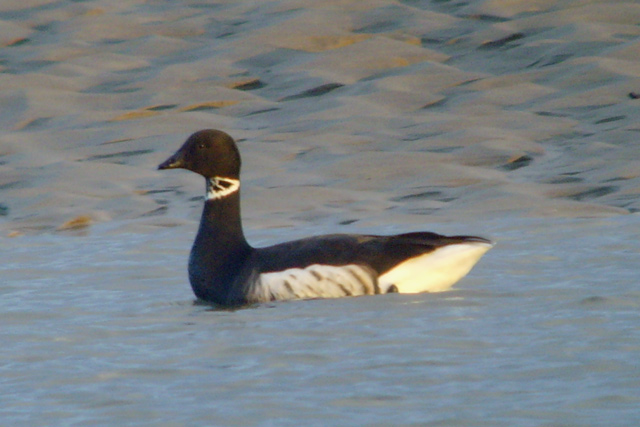
Black Brant, Killala, Mayo (Photo: Richard Bonser)
In Mayo, the drake Black Duck was again noted at Sruhill Lough, Achill Island on 13th — if it refers to the same individual, it has now been present at least eleven years! The drake American Wigeon was again at Loch of Strathbeg (Aberdeenshire) on 10th, with others still on the Exe Estuary (Devon) and Angler's Country Park (W Yorks) to 15th and the female again at Bodenham Lake (Herefordshire) on 15th. A drake Blue-winged Teal was again at Threave (Dumf & Gall) on 10th–14th, with the young bird also still on St. Mary's (Scilly) throughout. Eight Green-winged Teals included new drakes at Loch of Strathbeg (Aberdeenshire) on 11th, Emlagh Lough (Mayo) on 12th and Loch a'Phuill, Tiree (Argyll) on 14th, and another was again at Fairburn Ings (W Yorks) on 15th. Others were still at Kinneil Lagoon (Forth), Holy Island (Northumberland), Eyebrook Reservoir (Leics) and Tacumshin (Wexford).

Green-winged with Common Teals, Kinneil Lagoon, Forth (Photo: Anne Cotton)
Although the continuing female/immature Bufflehead at Helston Loe Pool (Cornwall) has good credentials as a genuine vagrant, a female Hooded Merganser at Whetsted Gravel Pits (Kent) on 10th is likely to be subject to a bit more scrutiny. The female Lesser Scaup was still at Slimbridge (Glos) to 13th, with drakes still at Lough Gill (Kerry) to 12th, Cosmeston Lakes (Glamorgan) to 14th and Siblyback Lake (Cornwall) to 15th. Drake Ferruginous Ducks were still at Woolhampton Gravel Pits (Berks) and Wimbleball Lake (Somerset) to 13th.

Bufflehead, Helston Loe Pool, Cornwall (Photo: Steve Bury)
Fourteen Ring-necked Ducks included six in Ireland, where new birds at Lough Ennell (Westmeath) on 11th, Emlagh Lough (Mayo) on 12th and Knockaderry Lake (Waterford) from 12th joined others still at Ballyshunnock Reservoirs (Waterford) and the two still at Carrowmore Lake (Mayo). A female at Coot Loch, Benbecula (Outer Hebrides) on 11th was the only new British bird; females remained at Hatfield Moors (S Yorks) and Wroxham Broad (Norfolk), while drakes were still at Par Beach Pool and Gwithian (Cornwall), Cowpen Bewley (Cleveland) and Chard Junction (Dorset, two).
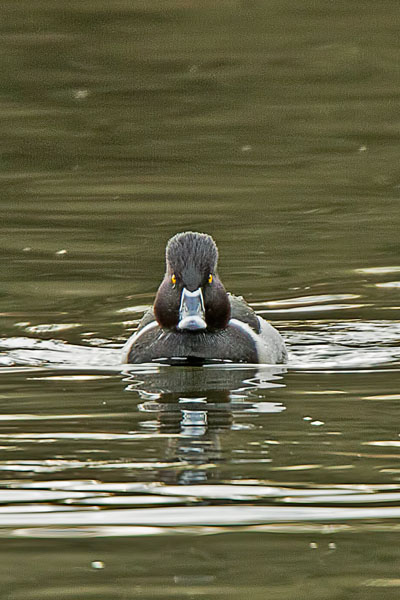
Ring-necked Duck, Cowpen Bewley, Cleveland (Photo: Ron Marshall)
There were still bucketloads of Smew around during the week. Birds became more widespread, although peak counts came from traditional sites: 31 at Rutland Water on 12th, 29 at Minsmere (Suffolk) on 9th, 25 at Dungeness (Kent) on 14th and up 15 at Wraysbury Gravel Pits (Berks), in addition to 16 at the less familiar site of Southwold boating lake (Suffolk) on 9th. Female Surf Scoters were still off Morfa Nefyn (Gwynedd) to 13th and Dawlish Warren (Devon) all week while the young drake was again in Mount's Bay, being seen off Marazion on 12th–15th.

Smew, Melton, Suffolk (Photo: Chris Mayne)
A Cattle Egret over Sandy Point (Hants) on 12th was the isolated new bird of the week, with the Warblington bird last noted on 11th. After last being seen in early December, one was again at Lydney (Glos) on 13th; meanwhile the Hillsborough (Down) bird roosted on 13th–14th. On Jersey, one was still at Grouville Marsh on 13th–14th. All but three of around 25 Great White Egrets this week were in England, and included twos still at Sutton Bingham Reservoir and Ham Wall (Somerset). The wandering White Stork was finally pinned down at the glamorous location of Kirkby-on-Bain landfill site (Lincs) from 9th, where it seemed rather content to scrot around for tasty morsels among the gulls. The Nottinghamshire escape was seen at Market Warsop on 11th.
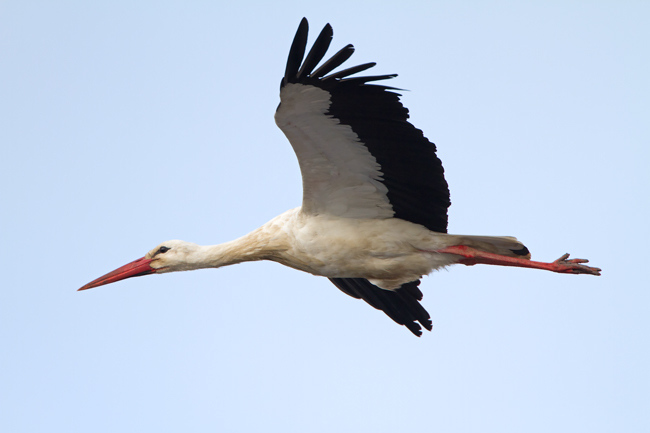
White Stork, Kirkby on Bain GPs, Lincolnshire (Photo: Russ Telfer)
Glossy Ibises were still present in excellent numbers, albeit not as high as over the previous fortnight. The flock at Carew Cheriton (Pembrokeshire) reduced from 13 birds to four through the week, although there were still three at Marloes on 13th. Other Welsh birds were still at Borth (Ceredigion) throughout and over St. Athan (Glamorgan) on 10th. English records included one touring the Weymouth (Dorset) area on 14th–15th, with presumably the same bird seen previously in the county at Canford, Wareham and Swineham on 12th. Another well-tracked individual was seen in a garden at Barnham (W Sussex) on 11th, before relocating to Cuckmere Haven on 13th then Scotney Gravel Pits and Dungeness (Kent) on 14th. Others were at Thurlestone, Powderham and the Torridge Estuary (Devon), Shapwick Heath (Somerset) and Leighton Moss (Lancs), while an uncounted flock was still in Scotland at Eigg (Highland). A sole Irish record came from Timoleague (Cork) on 10th.

Glossy Ibis, Borth, Ceredigion (Photo: Kev Joynes)
A White-tailed Eagle drifting north over East Hyde (Beds) during the afternoon of 10th no doubt gave county listers optimism for what would be an excellent local tick. However, it was not to be — it flew over Rye Meads (Herts) the following lunchtime, and what was presumably the same bird was reported offshore at Leysdown on the Isle of Sheppey (Kent) later in the day. The final in a series of records came from Botolph's Bridge near Romney Marsh (Kent) on 14th. In Galway, the Pallid Harrier was again seen roosting at Lough Corrib on 12th. At least eighteen Rough-legged Buzzards included twos at The Burgh (W Sussex) and Holkham (Norfolk), while the Irish bird continued at Kilcoole (Wicklow). Significant inland records came from Whetstone Gate on Ilkley Moor (W Yorks) and a wandering bird seen on the South Yorkshire/Derbyshire border.
Perhaps due to the lack of thawed ground, Ayrshire's Pectoral Sandpiper proved difficult to pin down, although it was again at Loans on 12th. The adult Spotted Sandpiper was still at Chew Valley Lake (Somerset) on 10th, with first-winters lingering on the Plym Estuary (Devon) and Stanpit Marsh (Dorset) throughout. There was no news on the Somerset Lesser Yellowlegs, although two Long-billed Dowitchers were again at The Cull (Wexford) on 12th. A spontaneous (although not unprecedented) weather-related occurrence was a Stone Curlew at Angmering (W Sussex) on 12th.

Spotted Sandpiper, Christchurch Harbour, Dorset (Photo: Chris Barlow)
The majority of 29 Ring-billed Gulls were to be found in Ireland: up to three were at Blennerville (Kerry) during the week, and two adults were at Lough Aderra (Cork), Nimmo's Pier (Galway) and Limerick town respectively. Further new birds were at Ballyneety (Waterford), Timoleague (Cork), Lahinch (Clare), Ardtermon (Sligo) and Donnybrewer (L'derry). Just six British records included a new adult at Dogsthorpe Tip (Cambs) on 9th, with others again at Pitsea landfill site (Essex) on 11th and Chew Valley Lake (Somerset) the following day. The only Scottish record was represented by the first-winter again at Barassie (Ayrshire).

Ring-billed and Common Gulls, undisclosed site, Essex (Photo: Steve Arlow)
Iceland Gull numbers were still extremely high this week, with peak counts including up to 65 still around Marwick (Orkney), 42 at Lerwick (Shetland), 32 at Stornoway Harbour, Lewis (Outer Hebrides), 20 at Killybegs (Donegal) and 19 at Corbally Road Reservoir (Antrim). In addition, further birds continued to filter south onto the British mainland, with four at Beddington Sewage Farm (London) on 14th epitomizing this. The highest Kumlien's Gull concentrations also came from the same sites; up to five were in the Marwick area, with three at Lerwick and twos at Ardglass (Down) and Ballycotton (Cork) in addition to significant records from Worcestershire, Lincolnshire, London and Kent. Glaucous Gulls were again present in smaller numbers, with 11 at Ardivachar Point, South Uist (Outer Hebrides) on 14th being the largest concentration.
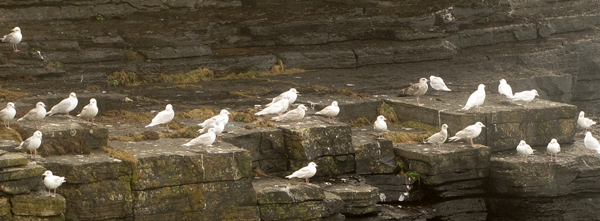
Iceland Gulls, Marwick, Mainland, Orkney (Photo: Alastair Forsyth)

Kumlien's Gull, Ardglass, Down (Photo: Mick Southcott)
The adult Bonaparte's Gull was again at Cardiff Bay (Glamorgan) on 15th, with the Northern Irish adult still at Ballygalley (Antrim) on 12th–15th. The adult Forster's Tern was again seen floating around off Traught (Galway) on 11th.
It was very much a continuation of previous weeks as far as passerines were concerned. The Richard's Pipit was still at Wyke Regis (Dorset) to 14th, with the Hume's Leaf Warbler also still in residence there. The male Desert Wheatear was still at Bempton Cliffs (E Yorks) on 9th but not subsequently — perhaps the cold conditions finally forced this little star on to pastures new. Although it may not come to much, a report of a male Northern Wheatear at Cople (Beds) on 15th is a timely reminder that the arrival of the first spring migrants is only just around the corner.
A remarkable four Yellow-browed Warblers were at Carnon Downs (Cornwall), with one remaining there on 14th. In Devon, birds remained in Plymouth on 9th and Exmouth to 15th, with lingering individuals also in Somerset at Chew Valley Lake to 12th and Combe St. Nicholas to 15th. Two Dusky Warblers were on Scilly: one still on St. Mary's on 12th, and another on Tresco the same day.

Yellow-browed Warbler, Chew Valley Lake, Somerset & Bristol (Photo: Gary Thoburn)
A reasonable showing of 27 Great Grey Shrikes were, as usual, predominately scattered around England. New English records included one on moorland near Temple (Cornwall) on 9th, while at least three were scattered around the New Forest. Three Welsh birds were at Alwen Reservoir (Conwy), Mynydd Illtyd (Powys) and Llwyn-on Reservoir (Glamorgan). Two new birds in Forth — at Kilmahog and Dunblane — were the headliners of four Scottish records.

Great Grey Shrike, Kilmahog, Forth (Photo: Ian Fulton)
Given the species' penchant disappearing for long periods, a Penduline Tit at Leighton Moss (Lancs) on 11th could easily be that seen there in November 2011. Up to two Northern Long-tailed Tits continued at Luddenden Dean (W Yorks) all week, visiting fat balls in gardens near the bridge.
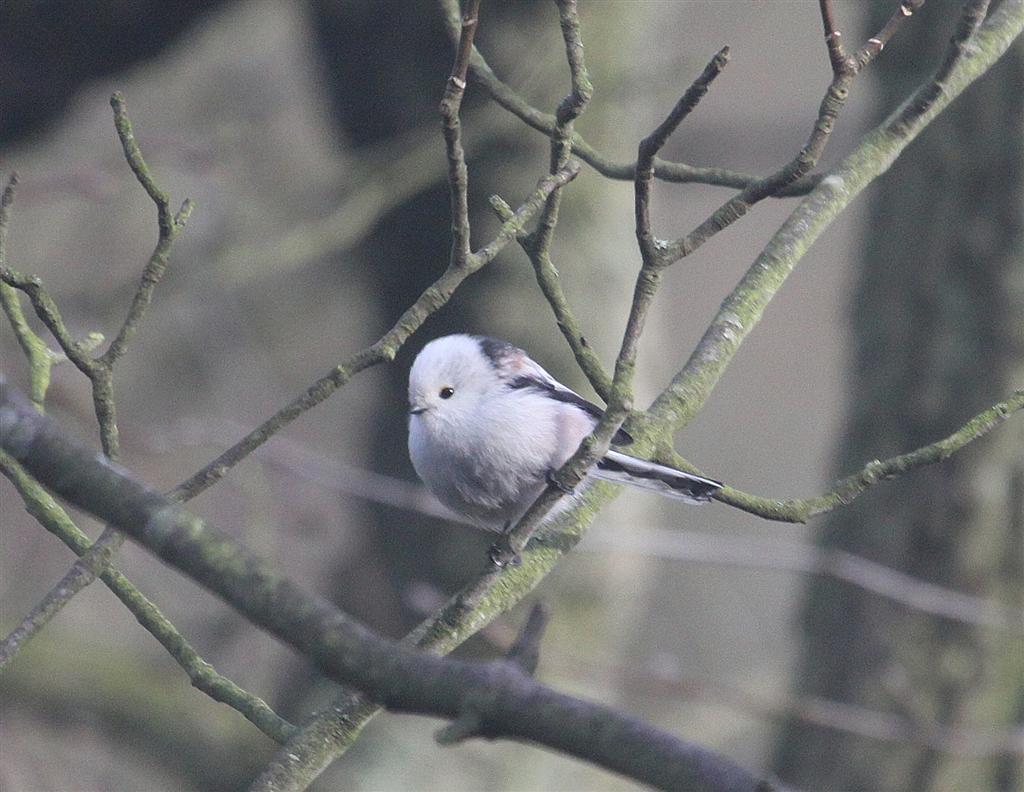
Northern Long-tailed Tit, Luddenden Dean, West Yorkshire (Photo: Michael Foley)
A Coues's Arctic Redpoll was again in gardens at Kelling (Norfolk) from 11th, now sporting a shiny new ring. Just along the coast, the long-stayer also continued to perform well at Titchwell. Finally, the House Crow was again reported along the seafront at Cobh (Cork) — the first time since January 7th.

Coues' Arctic Redpoll, Kelling, Norfolk (Photo: Tom Hines)
Photo of the Week: 9th–15th February

Brown Pelican, Ecuador (Photo: Ian Fulton)
Late last year, well-travelled bird photographer Ian Fulton enjoyed an eight-day cruise around the Galapagos Islands, enabling him to add a few hundred more images to the 9000 he has already posted in his online galleries. We're pleased to see that he's also shared a selection of these through BirdGuides, where he has posted over 700 images over the last nine years. The Galapagos archipelago is obviously world famous for the unique evolution of both its species and their behaviours. Our pick of Ian's images depicts one such behaviour as a Brown Noddy waits to try to rob a fishing Brown Pelican of its catch. What makes the scene both incredible and humorous, though, is that the Noddy is perching on the head of the apparently unperturbed Pelican! A great behavioural shot that finally earns Ian his first Photo of the Week.
Other notable photos

Short-eared Owl, Crosby, Lancashire (Photo: John Conway)

Sparrowhawk, Castle Douglas, Dumfries & Galloway (Photo: Chas Moonie)

Robin, private site, Cheshire (Photo: Steve Round)

Little Grebe, Toft Newton Reservoir, Lincolnshire (Photo: Nick Clayton)

Little Egret, National Wetlands Centre, Carmarthen (Photo: Wayne Davies)
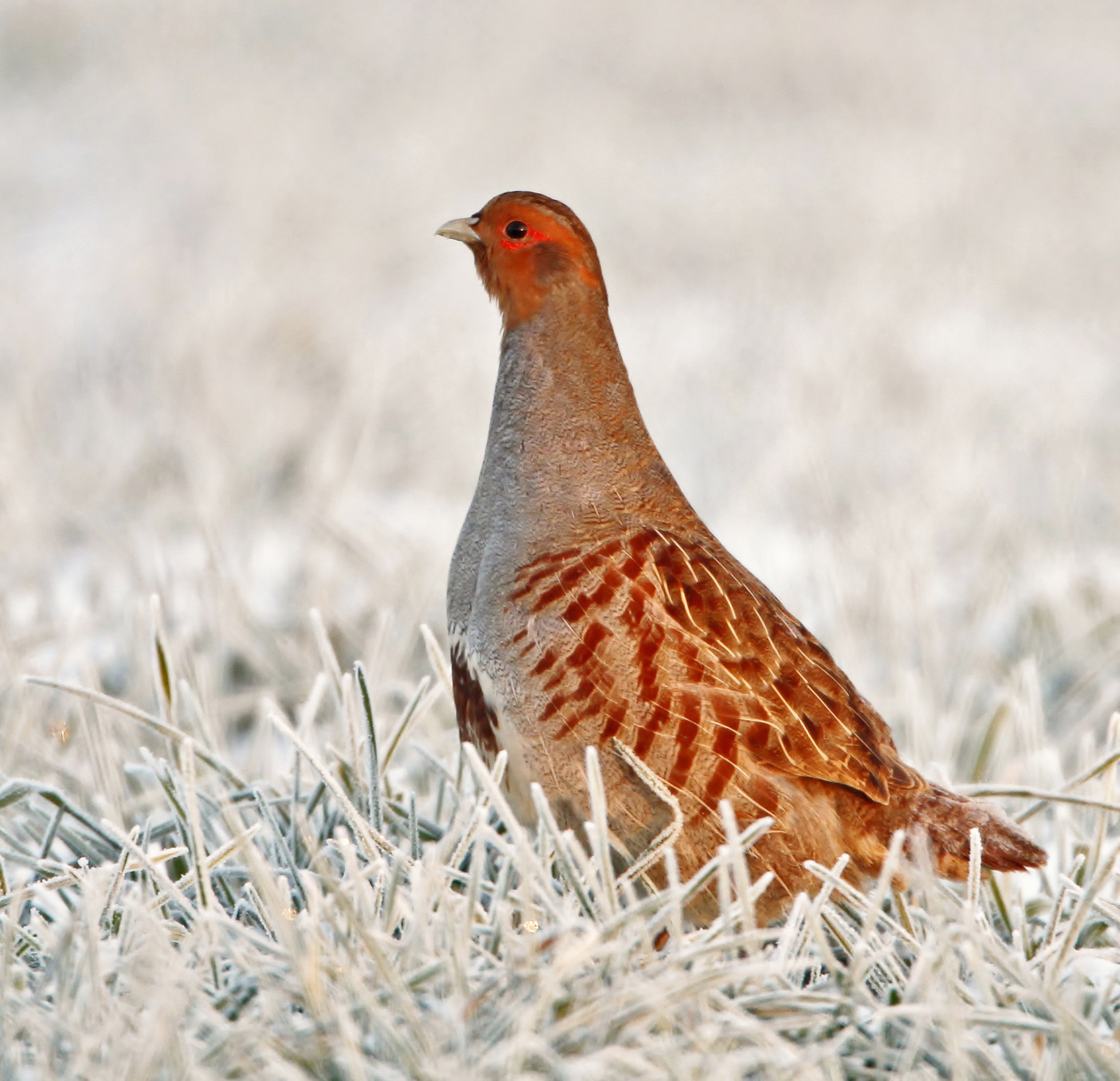
Grey Partridge, Fressingfield, Suffolk (Photo: Ian Clarke)

Woodcock, Walmer, Kent (Photo: Nigel May)

Purple Sandpiper, Aberdeen, Aberdeenshire (Photo: Alan Sinclair)

Bearded Tit, Minsmere RSPB, Suffolk (Photo: Carl Wright)

Golden Plover, Southwold, Suffolk (Photo: Tony Belsham)

Crested Tit, Rothiemurchus, Highland (Photo: Steve Knell)

Snow Bunting, Salthouse, Norfolk (Photo: Andy Thompson)

Spotted Redshank, Titchwell RSPB, Norfolk (Photo: Chris Upson)

Fieldfare, Yoxford, Suffolk (Photo: Jon Evans)

Middle Spotted Woodpecker, Poland (Photo: Artur Stankiewicz)

Ring-billed Gull, Gosport, Hampshire (Photo: Dave Barnes)

Goosander, undisclosed site, Clwyd (Photo: Richard Steel)

Red Kite, Stokenchurch, Buckinghamshire (Photo: Ian Curran)


